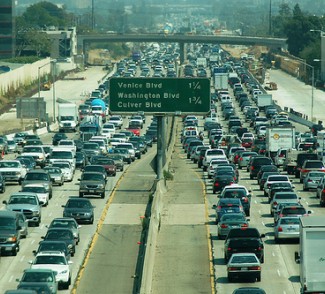Just before we went on holiday break, U.S. DOT’s Inspector General’s office released a document [PDF] detailing the department’s top challenges for the year ahead. The document calls them “management challenges” but by and large it’s just a list of seven things the Inspector General thinks DOT needs to do to meet its mission of providing a “safe and well-managed transportation system” to strengthen the U.S. economy and improve “the quality of life for the traveling public.”

Here are the seven priorities the Inspector General came up with:
- Improving FAA’s Oversight of the Aviation Industry and the Operations of the National Airspace System
- Identifying and Addressing Root Causes of Problems With NextGen and Setting Investment Priorities
- Continuing Actions To Strengthen Highway, Transit, and Pipeline Safety
- Improving Oversight of Surface Infrastructure Investments and Implementing Statutory Requirements
- Implementing Requirements To Address the Federal Railroad Administration’s Expanded and Traditional Responsibilities
- Managing Acquisitions and Contracts To Achieve Results and Save Taxpayer Dollars
- Building a Secure and Modern Information Technology Infrastructure
All worthy goals, but we have a few more things we’d humbly submit to DOT for their 2014 to-do list:
- Replace Polly Trottenberg with someone exactly like her. We’d be crushed to see a new policy chief at DOT who didn’t share Trottenberg's commitment to breaking down modal siloes, reconsidering old traffic projections and transportation plans, and protecting taxpayers from wasteful projects that perpetuate an outdated and unsustainable system. Trottenberg was an excellent replacement for Roy Kienitz, whom we also still miss. May the legacy of first-rate Under Secretaries for Policy continue. (And while we're on the subject, may ex-FHWA chief Victor Mendez be as consistent an advocate for walking and biking as his predecessor in the Deputy Secretary position, John Porcari.)
- Measure congestion in a way that doesn't create more traffic. If the problem you're trying to solve is that people are wasting too much time behind the wheel, then it makes no sense to build roads that cause people to drive even longer distances. And yet, the traditional performance measurement for congestion leads to exactly this outcome. Instead, the metric for congestion should be based on considerations like total travel time and the diversity of transportation options, not how car commutes stack up against the impossible ideal of free-flowing traffic. Also, "system performance" should be defined more broadly than just roadway speed.
- Take bicycle and pedestrian safety seriously. Last year's safety summits set a great precedent. Let's have more of those, plus a separate safety performance measure for non-motorized transportation.
- Release a freight plan that respects cities. As the star-studded Freight Advisory Council meets to forge a long-overdue national freight plan, it should take into consideration the needs of cities and the unique challenges of moving large trucks in and through them without compromising walkability and safety for all users.
- Keep up the collaboration with HUD and EPA. Lisa Jackson has left EPA and Ray LaHood has left DOT. Congress has made the Partnership for Sustainable Communities’ budget into a blood sacrifice at the altar of deficit reduction, or at least, right-wing pandering. But we know that even if the excellent sustainability grant programs are temporarily halted, the cross-fertilization goes far beyond that. The new Location Affordability Index indicates these three agencies are still committed to policy that recognizes the inextricable link between housing and transportation. That needs to continue.
- Be an active player in the negotiation for a new bill. DOT laid pretty low in the lead-up to MAP-21 once Congress made it clear that without a funding stream, the president’s recommendations were dead on arrival. This time around, some members of Congress have made clear that they expect the reauthorization to address only the (exceptionally thorny) issue of money and more or less let the MAP-21 policies stand. DOT has the best vantage point from which to recommend needed changes to the arcane but important formulas that determine how funding is allocated. DOT should speak out for funding based on merit and innovation, not tired formulas that are based on politics instead of the pursuit of excellence.
- Address concerns about the deadline for Positive Train Control. The rail industry has spoken with one voice about the installation of new safety technology: Rail companies and transit agencies are on board with doing it despite the exorbitant cost, but it simply can’t be completed by December 15, 2015. The FRA acknowledges this, but says the deadline is out of their hands because it was set by Congress. Rather than pass the buck, the agency could work with Congress and industry to change the deadline.
(Any other 2014 tasks for U.S. DOT? Put 'em in the comments.)
Congress has a long to-do list for 2014 too, as we see it -- with items like finding a sustainable funding source for transportation, inserting policy reforms into the reauthorization, and restoring parity between tax benefits for drivers and transit riders (preferably by reducing the tax break for parking).
But these seven items are things U.S. DOT could do on its own. With any luck, Secretary Anthony Foxx will prove up to these challenges.





